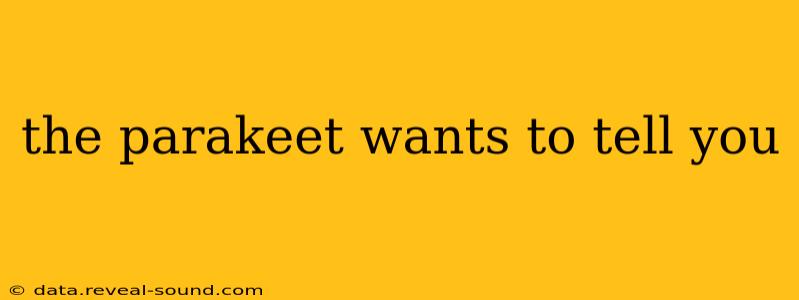The Parakeet Wants to Tell You: Decoding the Chirps and Squawks of Your Feathered Friend
Parakeets, those vibrant and intelligent little birds, often seem to have a lot to say. While they may not be able to articulate complex sentences like humans, their chirps, squawks, whistles, and body language are rich with meaning. Understanding your parakeet's communication is key to building a strong bond and ensuring their well-being. This guide delves into the fascinating world of parakeet communication, helping you decipher what your feathered friend is trying to tell you.
What are the common sounds my parakeet makes?
Parakeets use a variety of vocalizations to express different needs and emotions. High-pitched chirps often indicate happiness and contentment, while low-pitched chirps or squawks might signify fear, discomfort, or hunger. Loud, repetitive squawks can be a sign of distress, especially if accompanied by ruffled feathers or other signs of anxiety. Whistles, often learned from their owners or other birds, can express contentment or be a form of playful interaction. The context is crucial—observe your bird's body language alongside its vocalizations for a more complete understanding.
How can I tell if my parakeet is happy?
A happy parakeet is usually active, playful, and vocal. They'll chirp cheerfully, engage in preening (grooming their feathers), and may even sing or whistle. They'll readily interact with you and their environment, showing curiosity and a willingness to explore. Conversely, a lethargic bird that avoids interaction and shows little to no vocalization could be unhappy or unwell. Look for bright, clear eyes and smooth, glossy feathers as additional indicators of well-being.
My parakeet is making strange noises, what could be wrong?
Sudden changes in your parakeet's vocalizations can indicate illness or stress. Unusual noises, especially those accompanied by lethargy, loss of appetite, ruffled feathers, or changes in droppings, should prompt a visit to an avian veterinarian. While minor variations in vocalizations are normal, significant shifts warrant professional attention to rule out any underlying health issues. Even seemingly minor changes should not be ignored, as early intervention is often key in treating avian illnesses.
How can I better communicate with my parakeet?
Building a strong bond with your parakeet involves consistent interaction and attentive observation. Spend quality time with your bird, talking to it gently, and providing opportunities for play and exploration. Learn to recognize its individual vocalizations and body language patterns. Responding appropriately to your parakeet's communication strengthens your bond and ensures it feels safe and understood. This consistent interaction builds trust and strengthens the relationship, enriching both your lives.
What does it mean when my parakeet bites me?
Biting can be a sign of fear, frustration, or pain. While some parakeets are naturally more nippy than others, a sudden increase in biting could indicate a problem. Ensure your parakeet is comfortable with your handling and doesn't feel threatened. Avoid sudden movements and handle it gently. If the biting persists, consider consulting an avian behaviorist to address any underlying issues. Proper training and understanding your bird's temperament are essential to minimizing nipping behavior.
Conclusion:
Understanding your parakeet's communication is a journey of discovery. By paying attention to their vocalizations, body language, and behavior, you can develop a deeper connection with your feathered companion and ensure their well-being. Remember, patience and observation are key to unlocking the secrets behind your parakeet's chirps and squawks. Each bird is an individual, so continued learning and attention to your specific parakeet is crucial.
